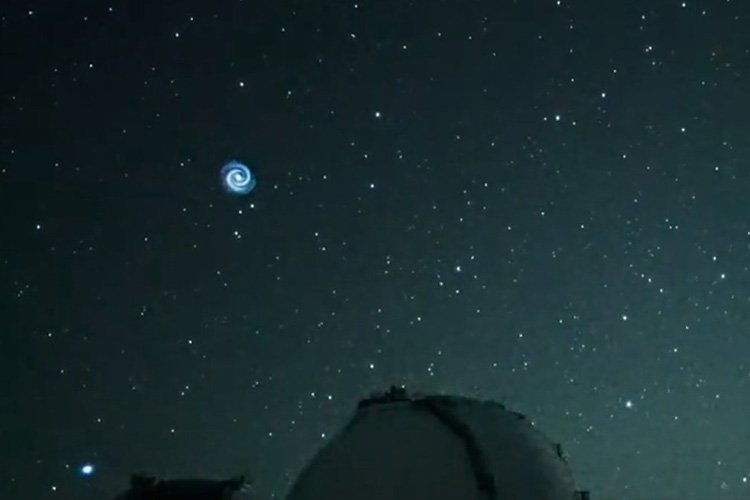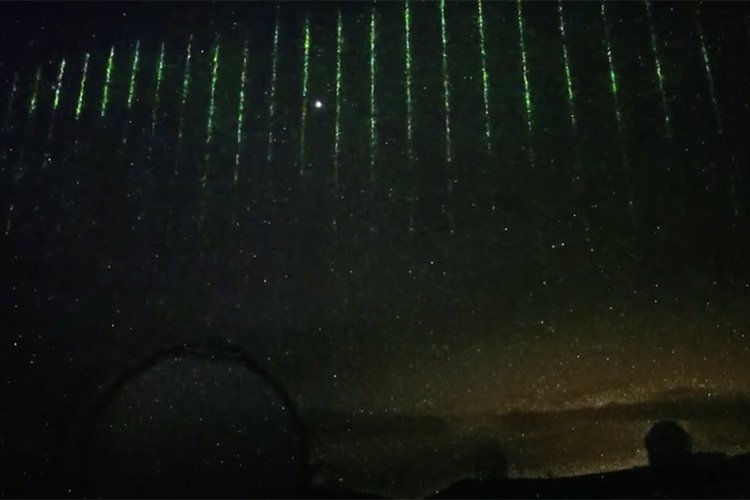In the past few weeks, the Subaru-Asahi telescope star camera has been capturing several bizarre sights in the night skies over Hawaii, including eerie blue spirals and ghostly green beams of light.
According to researchers, these extraordinary light shows have earthly origins and can be attributed to SpaceX and a Chinese research satellite.
On January 19, researchers shared a time-lapse video of a bright white orb slowly moving across the sky. After a few seconds, the white dot expands to form a perfect blue spiral. The celestial pattern grows into a ring shape before eventually fading away.
The strange scene was captured on January 18 by a Subaru’s live-streaming camera stationed atop Mauna Kea on Hawaii’s Big Island.


Certainly appearing to be otherworldly, researchers quickly determined the bizarre spiraling object was most likely related to a recent SpaceX Falcon 9 rocket launch. The two-stage partially reusable rocket took off from Cape Canaveral Space Force Station in Florida at 7:24 am on January 18 to deliver a GPS satellite into orbit for the U.S. Space Force.
This is not the first time bizarre blue spirals have been spotted following a SpaceX launch. In June 2022, observers as far away as New Zealand were treated to a near-identical scene following a Falcon 9 launch from Cape Canaveral.
“It looked like a beautiful galaxy,” said photographer Alasdair Burns of Twinkle Dark Sky Tours on New Zealand’s Stewart Island. “It was a very slowly rotating spiral that started small and gradually expanded. Eventually, it became so large and faint that it could no longer be seen. There were a group of us on our balcony watching it, and none of us had ever seen anything like it.”
According to experts, the spiral formation is caused by Falcon 9’s upper stage venting leftover fuel just before deorbiting into the Pacific Ocean. “The upper stage was probably spinning on its longest axis to stabilize flight orientation–hence the spiral shape,” Spaceweather.com wrote about the New Zealand sightings.
In 2018, a Dutch pilot of a Boeing 747 was even able to capture a photo of a Falcon 9’s green-blue spiral from the air while flying over east Africa.
SpaceX launches have also left behind other spectacular sights, like glowing clouds and “space jellyfish.” SpaceX’s Starlink satellite internet constellations have been accused of sparking reports of UFO sightings, potentially presenting a civil aviation safety hazard.
(Read More: Recent Pilot UAP Sightings Point to Aviation Safety Challenges, Experts Say )
Satellite trackers and citizen scientists on social media showed the location of the spiral object captured by Subura’s star camera closely matched where the second stage Falcon 9 rocket should have been after launch.
On January 28, Subaru’s star camera captured another odd and rare scene in Hawaii’s night skies.
In a brief video shared on the Subaru Telescope’s YouTube Channel, a bright green beam of light suddenly appears and quickly moves from left to right in front of the star camera.
The ghostly beam appears to come down from the heavens and somewhat resembles the downward-flowing green characters or “digital rain” used in the Matrix movie series to represent the computer code of a simulated reality.
Instead of capturing a glitch in the matrix, researchers initially believed the strange green lasers were caused by NASA’s ICESat-2 orbiting satellite and its onboard topographic lidar.
ICESat-2, or Ice, Cloud, and land Elevation Satellite 2 was launched in 2018 as part of NASA’s Earth Observing System Program. The sole instrument on The ICESat-2 is the Advanced Topographic Laser Altimeter, referred to as ATLAS. The system includes a powerful space-based lidar that beams 10,000 laser pulses a second to measure the elevation of ice sheets, glaciers, and other frozen and icy regions of the earth’s cryosphere.
However, the National Astronomical Observatory of Japan later updated its prior statement, saying that “NASA confirmed that its satellite was not the source of the green lasers over Hawai’i. Rather, it was most likely a Chinese satellite.”
“According to Dr. Martino, Anthony J., a NASA scientist working on ICESat-2 ATLAS, it is not by their instrument but by others,” the update stated. “His colleagues, Dr. Alvaro Ivanoff et al., did a simulation of the trajectory of satellites that have a similar instrument and found a most likely candidate as the ACDL instrument by the Chinese Daqi-1/AEMS satellite. We really appreciate their efforts in the identification of the light. We are sorry about our confusion related to this event and its potential impact on the ICESat-2 team.”
Launched in 2022, Daqi-1 is reportedly designed to monitor atmospheric pollution, similar to NASA’s ICESat-2.
In a 2021 press release , The state-owned China Aerospace Science and Technology Corporation said, “Daqi-1 can monitor fine particle pollution like PM2.5, pollutant gasses including nitrogen dioxide, sulfur dioxide and ozone, as well as carbon dioxide concentration.”
Maintained by the National Astronomical Observatory of Japan, the Subaru-Asahi telescope star camera frequently captures fascinating sky phenomena, including rare glimpses of red sprite lightning or massive fireballs that light up the sky as they enter the earth’s atmosphere.
With 13 telescopes from 11 countries in operation, the Subaru observatory is ideally situated to capture unique atmospheric events atop Mauna Kea on Hawaii’s Big Island. Stretching nearly 14,000 feet above sea level, the dormant volcano, Mauna Kea, is the tallest peak in Hawaii and the world’s second-highest summit on an island.
Most cloud cover stays below Mauna Kea’s summit, ensuring the air is dry and free of atmospheric pollution. Remotely located, the peak also offers exceptionally dark and clear night sky views, thanks to virtually no light pollution from a nearby population.
Ultimately, Mauna Kea’s exceptionally stable atmosphere makes it one of the best sites in the world for astronomical observation.
In 2021, the National Astronomical Observatory of Japan, in collaboration with the popular Japanese newspaper Asahi-Shimbun, launched the Subaru telescope sky camera, allowing anyone to watch the skies over Mauna Kea via a 24/7 live-stream video feed.
“You can enjoy not only the stars but also the beautiful spectacle of twilight to sunrise as if you were standing on the catwalk of the telescope dome!,” notes the Subaru Telescope website. “We really hope you and your family can enjoy the view.”
(This article was updated on 2/13/22 to include the correction by NAOJ that the “wall of green lasers” was likely caused by the Chinese Daqi-1 satellite and not NASA’s ICESat-2.)
Tim McMillan is a retired law enforcement executive, investigative reporter and co-founder of The Debrief. His writing typically focuses on defense, national security, the Intelligence Community and topics related to psychology. You can follow Tim on Twitter: @LtTimMcMillan. Tim can be reached by email: tim@thedebrief.org or through encrypted email: LtTimMcMillan@protonmail.com

